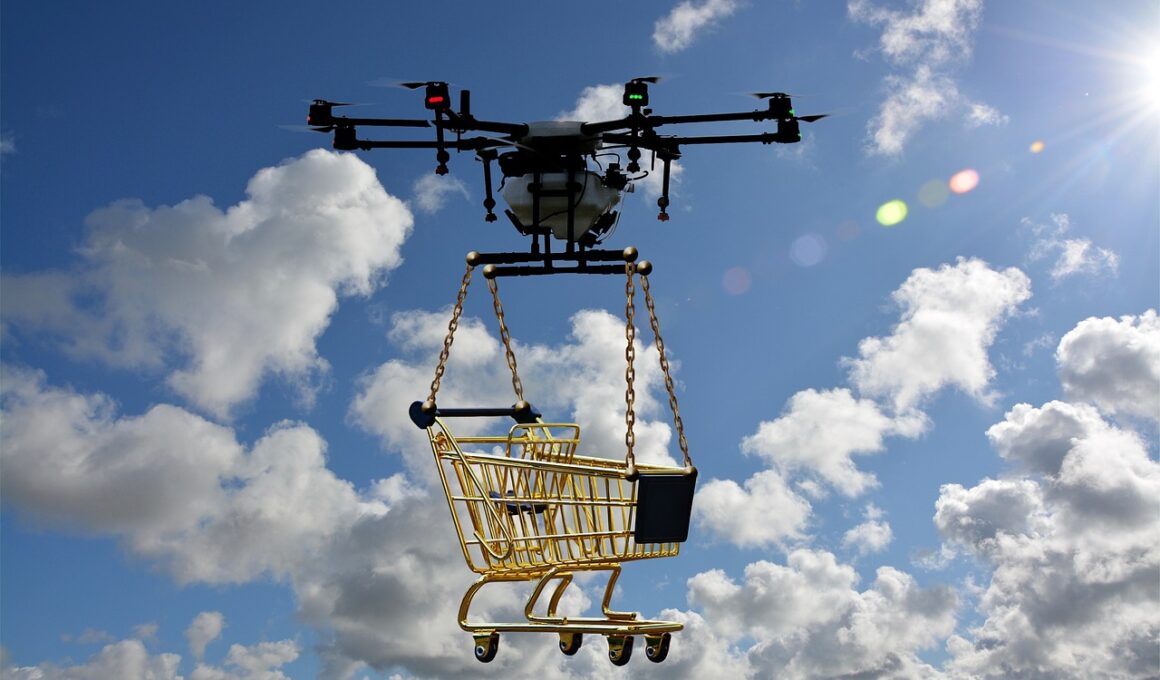The Impact of Delivery Drones and Robotics on E-Commerce Logistics
The landscape of e-commerce is rapidly evolving, and one of the most significant developments in recent years has been the advent of delivery drones and robotics. These innovations are revolutionizing logistics, enhancing efficiency, and meeting customer expectations for faster delivery times. Drones enable businesses to bypass traditional road networks, reaching rural and congested areas with ease. As e-commerce grows, so does the need for effective last-mile delivery solutions. The integration of robotics in warehouses automates sorting, packing, and shipping tasks, reducing human error and increasing throughput. With advancements in technology, drones are becoming more reliable and accessible, presenting opportunities for small and large companies alike. Companies like Amazon and Google have already started testing drone deliveries, which could reshape our understanding of logistics. Moreover, these innovations also contribute to sustainability goals by potentially reducing vehicle emissions associated with road deliveries. As we continue to explore these technologies, their impact on logistics efficiency and customer satisfaction becomes increasingly apparent, setting the stage for a new era in e-commerce deliveries.
With the incorporation of delivery drones into e-commerce logistics, businesses can expect a myriad of benefits. First, drones have the ability to significantly reduce delivery times, especially for short-distance logistics. As customer expectations for faster delivery continue to rise, meeting these demands becomes critical for e-commerce companies. In addition to speed, the cost-effectiveness of drone delivery operations serves as an attractive alternative to conventional delivery methods. Companies can save on fuel and labor costs while maximizing their operational efficiency. Furthermore, with advancements in battery technology, the range and payload capacities of drones are improving, enabling longer distances and heavier packages to be delivered. This increases the service areas that e-commerce businesses can cover without additional overhead. In urban environments where traffic congestion is a challenge, drones can take off from strategically located hubs, swiftly navigating the airways. This also reduces the carbon footprint associated with traditional delivery vehicles. As the sector matures, regulatory frameworks are also being developed to embrace drone technology safely. In conclusion, drones represent a transformative leap in logistics.
Robotics in Warehousing
While delivery drones grab the headlines, robotics in warehousing is equally disruptive in the e-commerce sector. Modern automated systems streamline warehousing operations, facilitating faster processing of customer orders. Robotics eliminates repetitive manual tasks through automation, enhancing productivity while minimizing human error. Advanced robots are designed to navigate warehouses, retrieve items, and even pack orders for shipment. This automation allows businesses to stock fewer items while still meeting customer demand. Additionally, robots can work around the clock, resulting in operational hours that exceed human capabilities. This translates into greater throughput during peak shopping periods such as holidays or promotional events. Furthermore, the integration of intelligent systems facilitates enhanced inventory management through real-time data tracking. Businesses can optimize stock levels, reduce overhead costs, and improve fulfillment speeds. Enhanced robotics can also adapt to varying order volumes, providing the agility needed in a fast-paced e-commerce environment. As labor costs rise and supply chains become more complex, businesses are compelled to invest in robotics to remain competitive. Consequently, the future will likely feature seamlessly interconnected robotic systems and human employees working alongside one another.
More importantly, adopting robotics can lead to notable improvements in workplace safety. By delegating hazardous tasks to robots, businesses can minimize the risk of workplace accidents, create safer environments for employees, and enhance overall morale. Improved safety not only has benefits for employees but can also lead to reduced insurance costs for businesses. As companies increase their reliance on robotics, the technology itself continues to evolve. A new generation of robots is emerging, equipped with artificial intelligence capabilities, enabling them to make decisions and learn from their environments. This adaptiveness could lead to greater operational efficiencies, as robots anticipate needs and act accordingly. Additionally, with predictive analytics, companies can better forecast demand, allowing for preemptive adjustments in inventory and staffing levels. One of the most promising aspects of integrating robotics within warehouses is the increased ability to respond to market demands dynamically. Businesses can proactively manage customer expectations by aligning resources with demand fluctuations, thereby improving customer satisfaction and operational output. As technology continues to advance, the collaboration between humans and robots will open new avenues for innovation in warehousing.
Impact on Customer Experience
The influence of delivery drones and robotics in e-commerce logistics extends directly to enhancing customer experience. With increased efficiency, businesses can meet delivery promises more reliably, which is a critical factor in customer satisfaction. Quick and reliable ordering processes facilitate positive shopping experiences, leading to repeat business and brand loyalty. Customers are becoming accustomed to an on-demand economy, where time-efficiency and convenience are paramount. Drones offer customers the ability to receive their purchases in a matter of hours instead of days, especially for urgent items such as electronics and health supplies. This rapid energy can drastically alter consumer behaviors as shoppers increasingly prioritize speed over options and pricing. Furthermore, the seamless integration of robots in order fulfillment provides accurate and timely information regarding order status. Customers can track their deliveries in real time, fostering transparency and trust. Enhanced logistics also reduces the risk of errors in order fulfillment, thus minimizing instances of order returns. The potential cost savings achieved through streamlined logistics can translate to better pricing strategies for consumers, positively influencing consumer decision-making. Therefore, implementing these advanced technologies can have a profound impact on overall customer loyalty.
However, while the benefits of delivery drones and robotics in e-commerce are substantial, there are challenges to consider. Regulatory constraints surrounding drone operations continue to evolve, with governments working to establish safety and privacy standards. The successful implementation of drones in urban areas raises concerns, including noise pollution and air traffic management. Striking the right balance between innovation and regulation will be key for e-commerce companies looking to utilize drones effectively. Moreover, investing in robotics technology can require considerable upfront capital, posing a challenge for smaller businesses to keep pace with larger competitors. The integration of advanced systems necessitates significant training efforts for the workforce to ensure coherence between human operators and automated systems. Compounding these challenges, the rapid pace of technological change can lead to obsolescence, necessitating ongoing investment in cutting-edge solutions. These considerations underscore the importance of strategic planning for businesses looking to integrate drones and robotics into their logistics processes. Evaluating the return on investment will be crucial for organizations as they navigate the complexities of adopting these emerging technologies.
The Future of E-Commerce Logistics
In summary, the impact of delivery drones and robotics on e-commerce logistics is poised to be transformative. Sustained advancements in drone technology lead to faster, more affordable delivery options. Robotics within warehouses enhances operational agility while ensuring accuracy in order fulfillment. As customer expectations evolve, businesses must adapt their logistics strategies accordingly to remain competitive. Consumer preferences increasingly dictate the need for innovative solutions, emphasizing the importance of quick deliveries and reliability. While integrating these technologies presents challenges—such as regulatory frameworks and significant investments—companies that navigate these landscapes successfully stand to gain a competitive edge. The ongoing enhancements in automation and artificial intelligence will further accelerate the efficiency of logistics operations. This makes it vital for businesses to stay informed about these technological trends while leveraging data analytics for improved decision-making. As a result, the future of e-commerce logistics points to increased efficiency, better customer experiences, and ultimately, enhanced profitability. Embracing innovation will enable businesses to thrive in an ever-evolving marketplace, thus redefining the boundaries of what is possible in e-commerce logistics.
In conclusion, the rise of delivery drones and robotics within the e-commerce logistics sector highlights the crucial intersection of technology and customer satisfaction. As logistics becomes increasingly crucial to winning consumer loyalty, businesses must prioritize investment in innovative delivery methods. This transition will be vital for catering to the modern consumer, who demands immediate gratification from their purchases. The choices companies make today will lay the groundwork for which e-commerce businesses lead the market tomorrow. As technology evolves, so too will consumer expectations, requiring organizations to adapt continually. The combination of enhanced logistics solutions, coupled with intelligent automation, will create a ripple effect across the e-commerce sector. Therefore, businesses need to strategically pivot or enhance their logistics models while considering the societal and ethical implications of deploying drones. As these transformative technologies shape the logistics landscape, the future of e-commerce promises not only smarter operations but also more sustainable and customer-centric practices. Notably, the collaboration of human workers with advanced robotics will drive creativity and innovation—fueling a cycle of ongoing improvement across various business sectors.


